Clyde Winters
![]()
![]()
Support for my decipherment of the Olmec writing comes from a bilingual Mayan-Olmec/Mande inscribed brick from Comalcalco. Comalcalco is a Mayan archaeological site found in Tobasco. Here archaeologist Neil Steede found over 4000 inscribed bricks at the Comalcalco site.
The Comalcalco site encompasses around 360 pyramids. Here almost all of the structures were built of fired bricks (tabiques) . Between 1977-1978, 9 of these pyramids were excavated.
Comalcalco is located in the State of Tabasco. It was built by the Chontal. It is the only city in Mexico built entirely of brick.
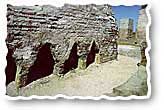
Comalcalco means "in the house of earthenware" in Nahuatl
This Mayan site has interesting architecture. For example, "The Great Acropolis" probably used for civil and religious purposes.
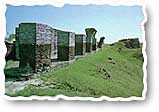
In addition to building fine temples, walls and altars, there are fine "stucco" used to face their constructions, which resemble images on the sub-pyramids of many Mayan sites, that have analogy to Olmec iconography.

Neil Steede became interested in the bricks in 1979. He obtained permission to photograph the bricks from the National Institute of Anthropology and History (NIAH).
Many of the inscribed bricks from the Comalcalco ruins were published by Neil Steede in a bilingual book entitled Preliminary Catalogue of the Comalcalco Bricks.
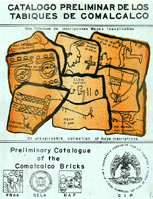
One of the bricks T1-452 R16 is a very interesting brick.
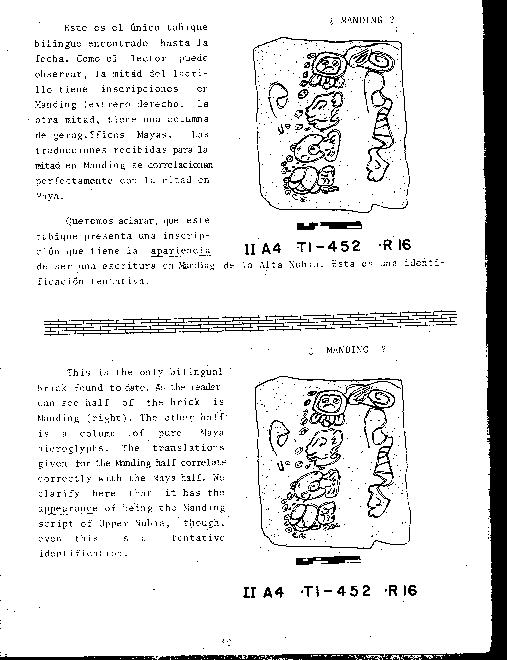
Brick T1-452 R16 is a very special brick. This brick has a bilingual Mayan-Olmec inscription. In this inscription we see a Mayan inscription , and beside it on the right hand side an Olmec/Malinke inscription .
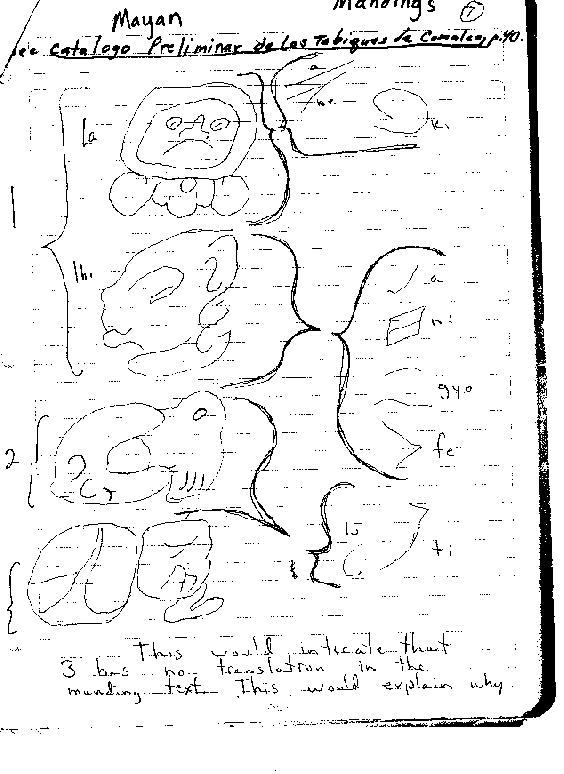
The Olmec writing used on this brick is the plain Olmec style of writing. The plain Olmec style of writing was usually used to inscribe celts and other Olmec artifacts.
On the far right hand side we see two additional characters. These characters also are written in the plain Olmec style of writing (The Decipherment of Olmec Writing).
Steede was advised by Dr. Alexander von Wuthenau, to send me copies of the bricks to determine if I could identify the writing on some of the bricks that appeared to Steede as similar to scripts used in the Old World in advance of his publication of the Comalcalco Catalogue. After an examination of the photographs I spotted the bilingual Olmec-Maya inscription.
I immdeately recognized that the T1-452 R16 brick appeared to be include both Mayan and Olmec inscriptions. To test this hypothesis, I suggested to Steede that he decipher the Mayan inscription , and I would decipher the Olmec passage which had been partially defaced.
Steede agreed to this test. He then divided the inscription into three segments (we were both to decipher) and we began our decipherments. Below is the division of the T1-452 R16 text:
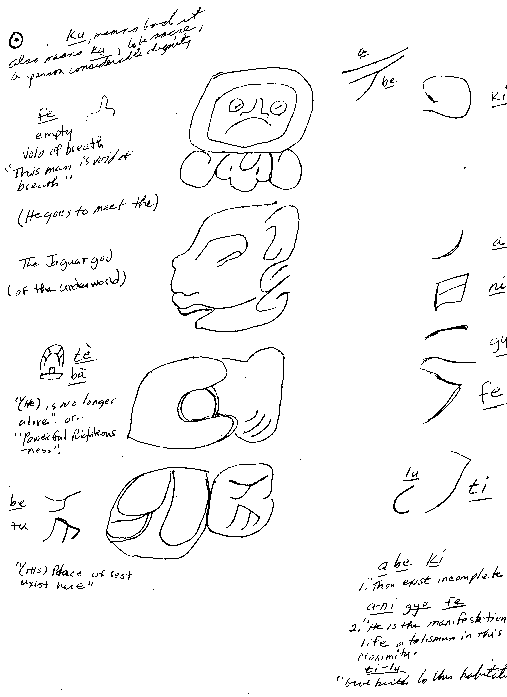
I sent a copy of my decipherment of T1-452 R16 to Steede. On this decipherment I include a translation of the Malinke inscription on the right-hand side of the T1-452 R16, and also the Olmec/Mande signs found inside of the Mayan glyphs. Please note in my decipherment that I had placed on this chart a breakdown of the Olmec/Mande signs and the plain Olmec signs found inside of the Mayan glyphs (as well). Below is a copy of the decipherment I sent to Steede in 1984.
Translation/Transliteration Olmec Plain Signs
|
A be ki |
|
a-ni gyo fe |
|
Ti lu |
Thou exist incomplete.
He is the manifestation of life, a talisman in this proximity.
Give birth to this [funerary] habitation.
Translation/Transliteration Olmec Signs inside Mayan Glyphs
|
Ku Fe |
|
The Jaguar god (of the underworld) |
|
Te ba |
|
Be Tu |
The person of considerable dignity is void of breath.
[He goes to me the] Jaguar God.
[He] is no longer alive/ or Powerful Righteousness!
[His] Place of rest exist here.
Steede wrote me back (28-3-84) that his interpretation of the Mayan signs was almost identical to my translation of the Mayan and Olmec/Mande signs. He wrote the following:
" 1A shows a face with slashed eyes (blind or non=seeing), nostriless nose (non-breathing) and "clamped shut" mouth ( non-speaking). This would indicate death alright, but below the cartouche is added onto by two breath scrolls on each side of an intricate sacraficial blade. These breath (or speak) scrolls indicate that the person in question has expressed that he feels as though he is "dead" spiritually and wishes t make a self-sacrifice.
1B underlines the fact that he is dead, but note the "S" in the ear of the jaguar. This indicates pentiteuce, or repentence. Therefore, though the person is "dead" spiritually he has heard and accepted repentence.
Therefore 1A and 1B together would read extremely similar to your hieroglyphic translation, but almost exactly as your Manding translation. The person in question is considered to be incomplete until he accepts the priesthood.
2 is identical to your Manding translation and similar to your hieroglyphic interpretation. The part to the right is a dorsal fish fin.
I don't have any notes infront of me but I believe it is Stela 1 of Izapa which shows that Quetzalcoatl "fishes" for all types of fish (men). This stela also implicates that the dorsal fish fin is associated with priesthood.
Here we can see the fish fin "hatching" from an "egg?" or from "inner self?" The person in question is being born again as a priest.
3. I can't understand, but your rendering would seem to be correct. He is now at rest because he is (complete)."
This translation of the Mayan side of this bilingual brick from Comalcalco , and other inscribed bricks from this site indicate that it was probably a Mayan College where scribes learned Mayan writing and possibily pyramid construction. The bilingual text on T1-452 R16, indicates that the Mayan scribes had to learn how to write Olmec inscriptions and translate them into Mayan. The fact that the Olmec inscriptions were defaced indicate that the Mayan scribes while they studied Mayan writing first wrote a piece in Olmec and then wrote the same inscription in the Mayan language(s)
Below we see T1-452 R16. If you look carefully at the brick we see two Olmec signs written vertically.
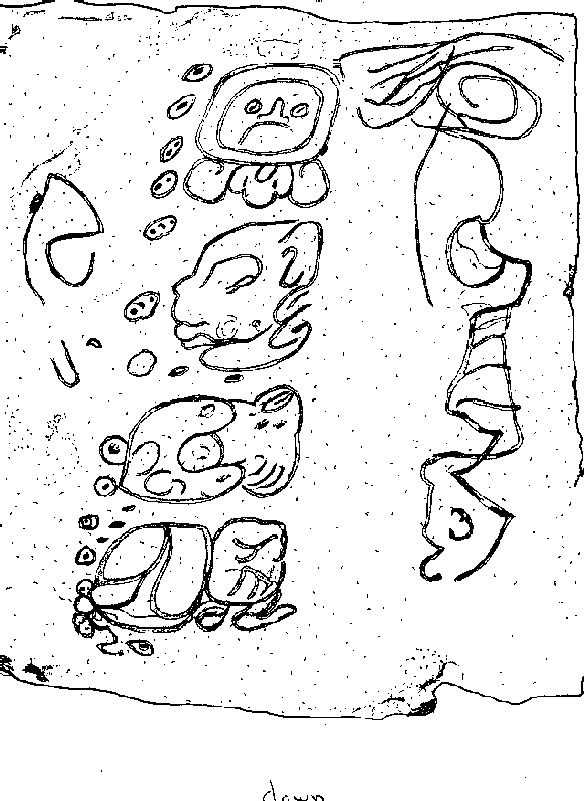
Reading from top to bottom we find the following signs Ma yo. The interpretation of Ma yo in Olmec is the following: "It's done well--full of life". These signs appear to indicate a grade or comment on the brick made by the instructor. This supports the view that Comalcalco was a College, where Mayan iniates into the priesthood and scribal classes learned how to write Mayan hieroglyphics.
B. Stross (1973) mentions the Mayan tradition for a foreign origin of Mayan writing. This idea is also confirmed by Mayan oral tradition (Tozzer, 1941), and C.H. Brown (1991) who claimed that writing did not exist among the Proto-Maya.
Terrence Kaufman has proposed that the Olmec spoke a Mexe-Zoquean speech and therefore the authors of Olmec writing were Mexe-Zoquean speakers. This view fails to match the epigraphic evidence. The Olmec people spoke a Manding (Malinke-Bambara) language and not Zoquean.
There is a clear African substratum for the origin of writing among the Maya (Wiener, 1922). All the experts agree that the Olmec people gave the Maya people writing (Schele & Freidel, 1990; Soustelle, 1984). Mayanist also agree that the Proto-Maya term for writing was *c'ihb' or *c'ib'.
1. Mayan Terms for Writing
|
Figure 1. Mayan Terms for Writing |
|
Yucatec c'i:b' Chorti c'ihb'a Mam c'i:b'at |
|
Lacandon c'ib' Chol c'hb'an Teco c'i:b'a |
|
Itza c'ib' Chontal c'ib' Ixil c'ib' |
|
Mopan c'ib' Tzeltalan c'ib' |
|
Proto-Term for write *c'ib' |
The Mayan /c/ is often pronounced like the hard Spanish /c/ and has a /s/ sound. Brown (1991) argues that *c'ihb may be the ancient Mayan term for writing but, it can not be Proto-Mayan because writing did not exist among the Maya until 600 B.C. This was 1500 years after the break up of the Proto-Maya (Brown, 1991).
Landa's tradition concerning the origin of writing among the Maya supports the linguistic evidence (Tozzer, 1941). Landa noted that the Yucatec Maya claimed that they got writing from a group of foreigners called Tutul Xiu from Nonoulco (Tozzer, 1941).
The Tutul Xi were probably Manding speaking Olmecs. The term Tutul Xiu, can be translated using Manding as follows:
Tutul, "Very good subjects of the Order".
Xiu, "The Shi (/the race)".
"The Shis (who) are very good Subjects of the cult-Order". The term Shi, is probably related to the Manding term Si, which was also used as an ethnonym.
The Mayan term for writing is derived from the Manding term: *se'be.
Below are the various terms for writing used by the Manding/Mande people for writing.
|
Manding Term for WritingMalinke se'be Serere safe |
|
Bambara se'be Susu se'be |
|
Dioula se'we' Samo se'be |
|
Sarakole safa W. Malinke safa |
|
Proto-Term for writing *se'be , *safâ |
Brown has suggested that the Mayan term c'ib' diffused from the Cholan and Yucatecan Maya to the other Mayan speakers. This term is probably derived from Manding *Se'be which is analogous to *c'ib'. This would explain the identification of the Olmec or Xi/Shi people as Manding speakers.There are also many cognate Mayan and Manding terms (Wiener, 1920-22) .
In conclusion, it is clear that the Olmec people introduced writing to the Mayan people. As a result the Mayan term for writing is of Olmec/Mande origin. This view is confirmed by the decipherment of T1-452 R16 by Steede and Winters discussed herein.
(The photos in this article from Comalcalco are found at: http://www.tabasco.gob.mx/pejecuti/organis/touris/arqueo/comal01.htm)
![]()
If you have comments or suggestions, email me at olmec98.net